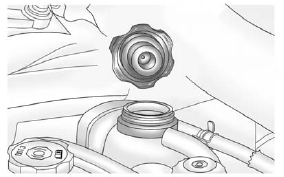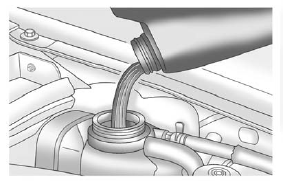How to Add Coolant to the Surge Tank
WARNING!
You can be burned if you spill
coolant on hot engine parts.
Coolant contains ethylene glycol and it will burn if the engine parts are hot enough. Do not spill coolant on a hot engine.
Notice: This vehicle has a specific coolant fill procedure.
Failure to follow this procedure could cause the engine to overheat and be severely damaged.
WARNING!
An electric engine cooling fan
under the hood can start up
even when the engine is not
running and can cause injury.
Keep hands, clothing, and tools
away from any underhood
electric fan.
WARNING!
Steam and scalding liquids from a
hot cooling system can blow out
and burn you badly. They are
under pressure, and if you
turn the surge tank pressure
cap—even a little—they can
come out at high speed.
Never turn the cap when the
cooling system, including the
surge tank pressure cap, is hot.
Wait for the cooling system and
surge tank pressure cap to cool
if you ever have to turn the
pressure cap.
If coolant is needed, add the proper DEX-COOL coolant mixture at the coolant surge tank.
If no coolant is visible in the surge tank, add coolant as follows:
1. Remove the coolant surge tank pressure cap when the cooling system, including the coolant surge tank pressure cap and upper radiator hose, is no longer hot. Turn the pressure cap slowly counterclockwise about one-quarter turn and then stop.
If you hear a hiss, wait for that to stop. A hiss means there is still some pressure left.

2. Keep turning the pressure cap slowly and remove it.

3. Fill the coolant surge tank with the proper mixture, to slightl y above the FROID/FULL COLD line on the side of the coolant surge tank.
4. With the coolant surge tank pressure cap off, start the engine and let it run until you can feel the upper radiator hose getting hot. The upper radiator hose is the top hose coming out of the radiator, on the passenger side of the vehicle. Watch out for the engine cooling fans.
By this time, the coolant level inside the coolant surge tank may be lower. If the level is lower, add more of the proper mixture to the coolant surge tank until the level reaches the FROID/FULL COLD line on the side of the coolant surge tank.
5. Replace the pressure cap.
Be sure the pressure cap is hand-tight and fully seated.
Notice: If the pressure cap is not tightly installed, coolant loss and possible engine damage may occur. Be sure the cap is properly and tightly secured.
Recheck the coolant level in the bottle next time you use your vehicle to ensure the system is full when cold.
See also:
Sedan and Wagon Model
From the outside, turn the key
toward the front or rear of the
vehicle, or press or
on
the Remote Keyless Entry
(RKE) transmitter. See Remote
Keyless Entry (RKE) System
Operation (Keyle ...
Replacing LATCH System Parts After a Crash
WARNING
A crash can damage the LATCH system in the vehicle. A damaged LATCH system may
not properly secure the child restraint, resulting in serious injury or even death
in a crash. To help ...
Playing from the Hard Drive Device
HDD (Hard Drive Device): Press
the HDD button to start playing
tracks from the HDD. HDD displays
and playback resumes from where it
was last stopped.
HDD Playback ModeThe infotainment system ...






